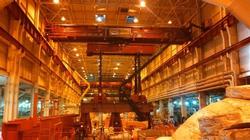
Whiting’s ultra-safe heavy lift saves millions in reduced plant downtime and hazards while turbines spin
The G2 girder (one of two 88-foot (26.6 meter) girders that were lifted 60 feet (18.28 meter) above the turbine floor and placed between the two operating units) coming down for a landing
A 2.2 gigawatt electricity generation plant in the U.S. is saving millions of dollars in maintenance outage costs as a result of the Whiting Corporation’s capability to install and commission a 250-ton turbine bridge crane while adjacent turbine generators ran at full power with no down time.
Safety was such a priority for the heavy lift at a nuclear generating station in Michigan, which produces enough power for a city of 1.25 million people, the Whiting team constructed an entire hydraulic heavy lifting and rotation test structure off-site in preparation for the actual installation.
Whiting Corporation says installing the bridge crane while the station was operating saved millions of dollars and a great deal of time prior to an upcoming refuelling outage. The innovative installation saved $18 million that would have been absorbed into the community rate base. The savings achieved in time and money are applicable to other turbine, generator and heavy lift applications across a wide range of industries seeking to enhance safety and avoid downtime.
Whiting’s innovative installation saved $18 million that would have been absorbed into the community rate base. This was achieved using multiple telescoping gantry systems and a hydraulic turntable to safely lift and rotate components for the 250-ton bridge crane with 60-ton auxiliary hoist.
It also cut the retrofit outage by a week, says Dave Weber, Director of Nuclear Services, Whiting Corporation. Whiting is a leading crane producer with overhead cranes in nearly all American nuclear and conventional power plants.
Applicable to diverse industries using turbines, the ultra-safe and time-saving safety lift and rotation project has won a global award for the operation to rig and lift more than five million pounds of components while adding a second Whiting crane to the plant’s generating room as part of an upgrade to enhance safety while curtailing downtime and potential accident hazards.
The award recognizing top industry practice in heavy lifting was made at the 2015 Power Engineering Awards hosted by Power Engineering, Renewable Energy World, and Nuclear Power international magazines during Power Generation Week in Las Vegas in December.
The Whiting Corporation lifting technology used multiple telescoping gantry systems and a hydraulic turntable to safely lift and rotate components for the 250-ton bridge crane with 60-ton auxiliary hoist. Two 88-foot (26.6 meter) girders were lifted 60 feet (18.28 meter) above the turbine floor and placed between the two operating units.
Workers configured the gantry system as an engineered temporary lift assembly that had never been used in such a manner during power operation. The design was less invasive to the plant structure. Thanks to the project, the industry now has a proven method for the practical application of a telescoping gantry system and a turntable for component rotation.
The second bridge crane will allow for a reduction in outage duration by as much as seven days in the upcoming turbine retrofit outage alone. All future outages will continue to realize additional costs savings, because a point of vulnerability has been eliminated through the addition of a second bridge crane.
Highlights of the lifting operation included:
290 lifts (86 classified as high-risk) all successfully completed
- The G1 girder weighed 110,000 lbs (nearly 50,000 kg), the G2 girder weighed 96,000 lbs. (nearly 44,000 kg), and the main trolley weighed 88,000 lbs (nearly 40,000 kg)
- More than 5.3 million lbs rigged and lifted (2,267,961 kg) including 650,000 lbs of test weight
- Zero safety incidents
Tolerances of 0.5 Percent
Such as the emphasis on safety that Whiting Corporation constructed an entire hydraulic heavy lifting and rotation structure off-site in preparation for the actual installation. This full-scale mock-up, which exactly replicated actual lifting conditions, was used to remotely load test the innovative telescoping gantry system and turntable technology to 125 percent of maximum load through the entire range of movements, while maintaining levelling tolerances to 0.5 percent.
Lifting the mock-up girder
The lifting team exceeded the provisions of Subpart 2.15 of ASME NQA 1-2008 quality assurance requirement, stipulating a dynamic load test equal to 110 percent of the rate load, instead choosing to proceed with a more conservative 125 percent rated load test. The trial also exceed the new ASME P30.1.2014 “Planning for Load Handling Activities” code issued during the project’s planning phase, which was exceeded despite not being part of the initial scope.
Test loads were intentionally taken beyond the operational limits to ensure there was sufficient margin to encompass any of several failure modes that could be encountered during installation. Controls were established to ensure the assembly of the gantry system was identical to that used during the demonstration, with redundant level control, LED levels and 3D Laser Scanning Total Station guidance, time lapse and live video of the entire sequence.
Lessons from Mock-up
“We learned from the mock-up that the system was rock solid even in 15-20 mph winds (approximately 32 kph). Fine control of the power towers easily kept the lift level, while the rotation motion was exceptionally smooth,” said Weber.
An additional total station and operator was added to monitor the power towers in the reverse operating direction and a communication protocol was established. The system was reviewed for compliance with the new ASME P30.1 and found to be in alignment with this latest code.
“The installation method require collaborative efforts between ourselves as the crane vendor, the utility and the installation contractor to manage the risk by preforming a robust demonstration of lifting operations, in addition to independent review of analytical calculations for the temporary engineering lift system,” said Weber. “The results allowed the owner to avoid opening the turbine building envelope during installation and to complete the work without impacting outage duration.”









